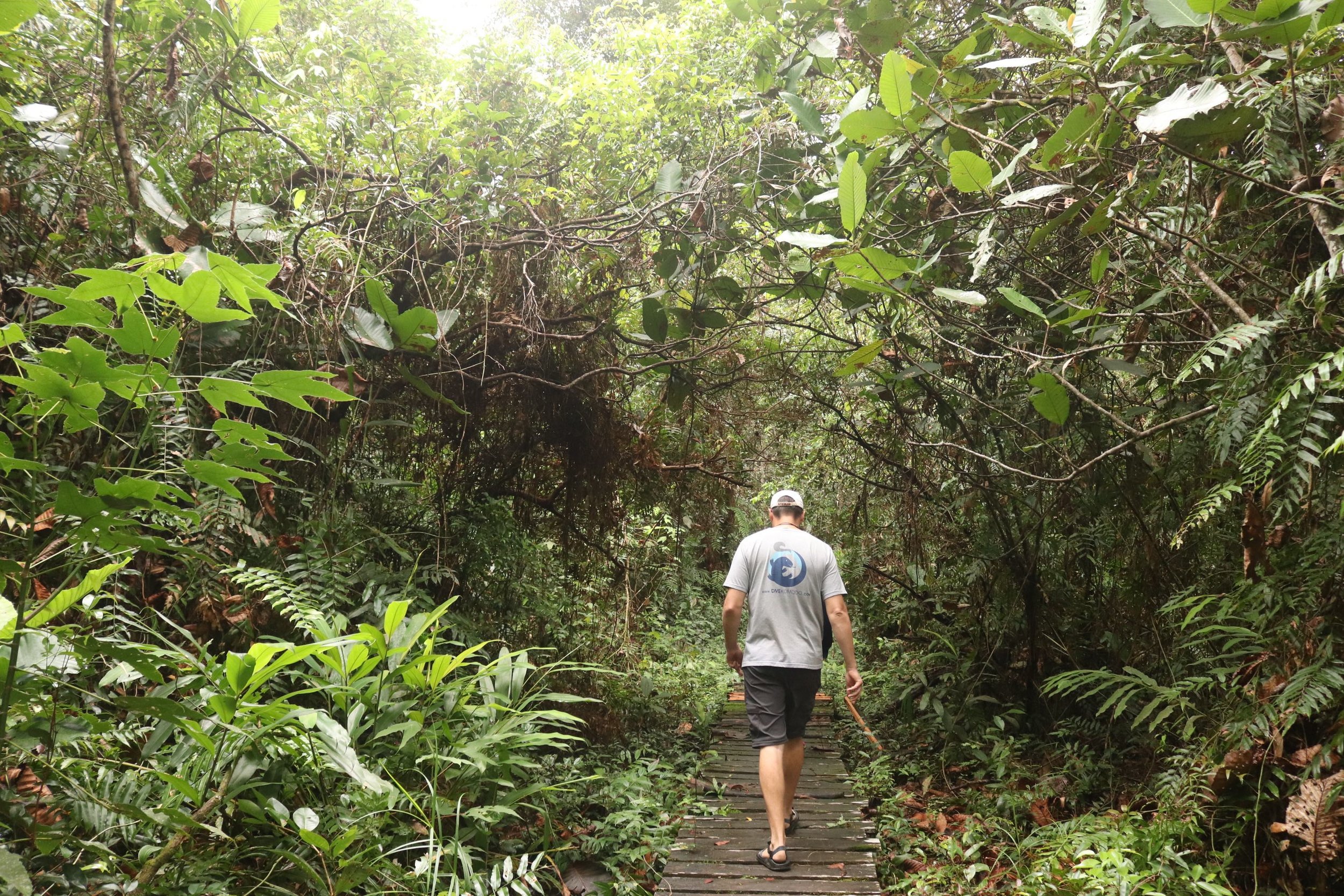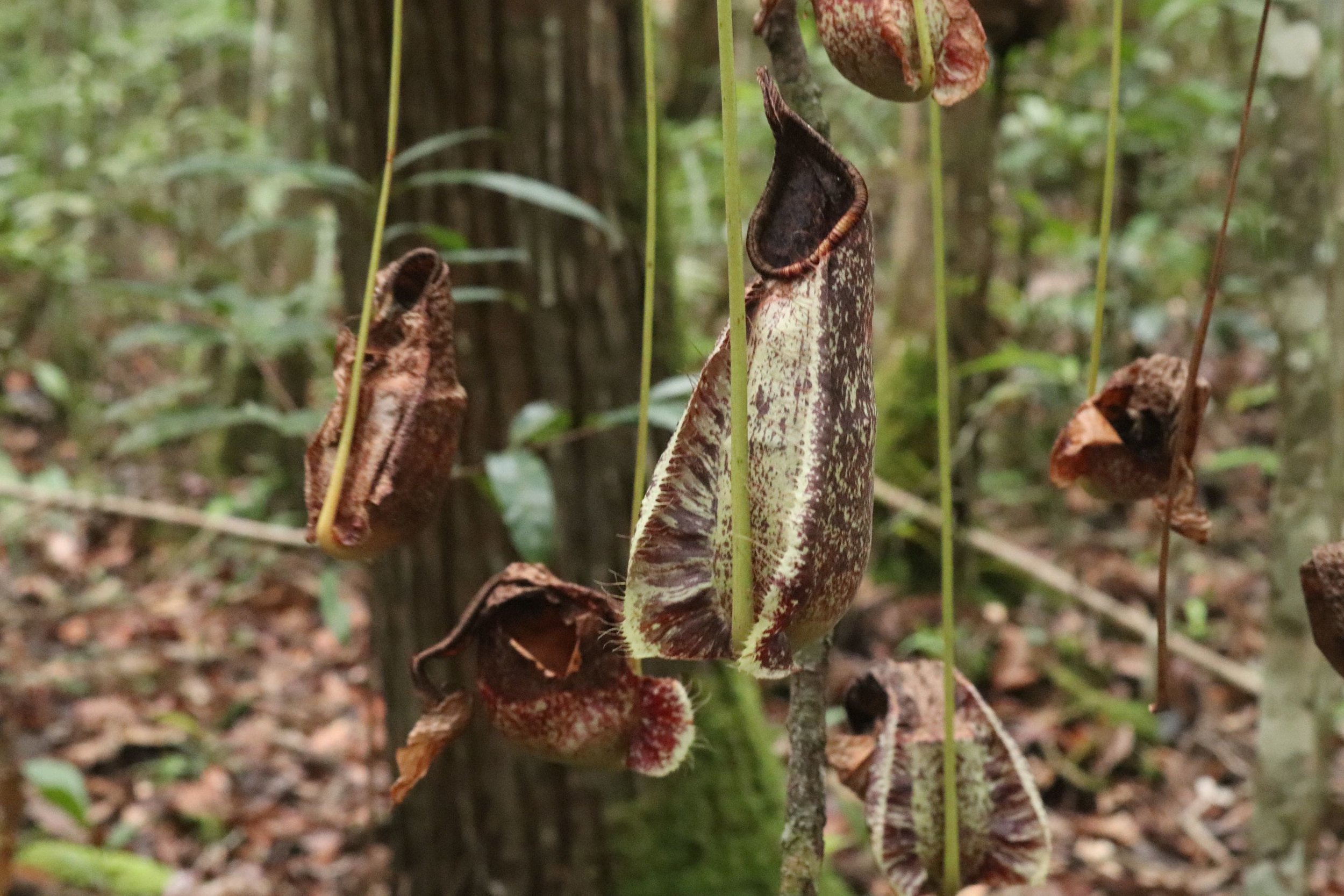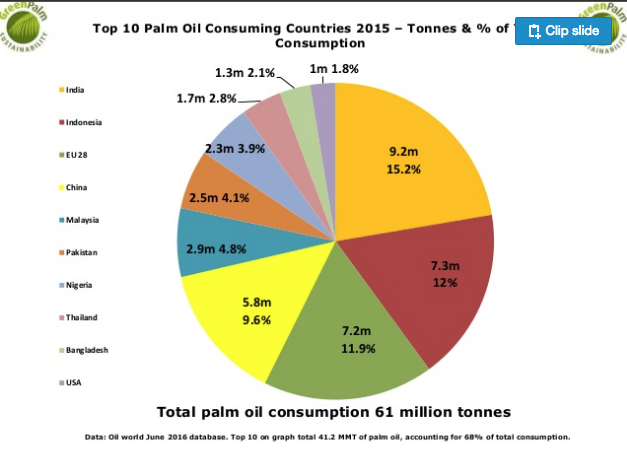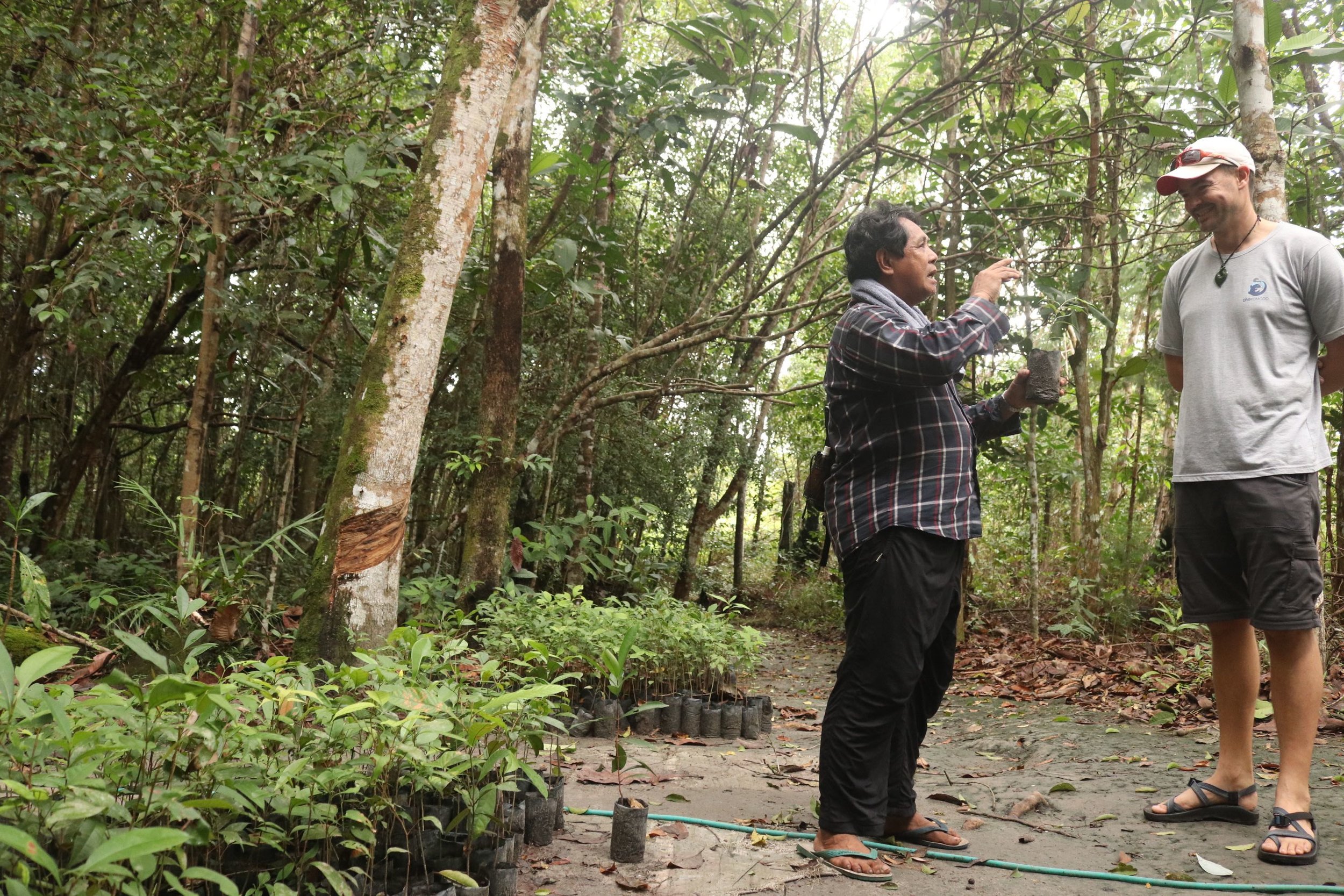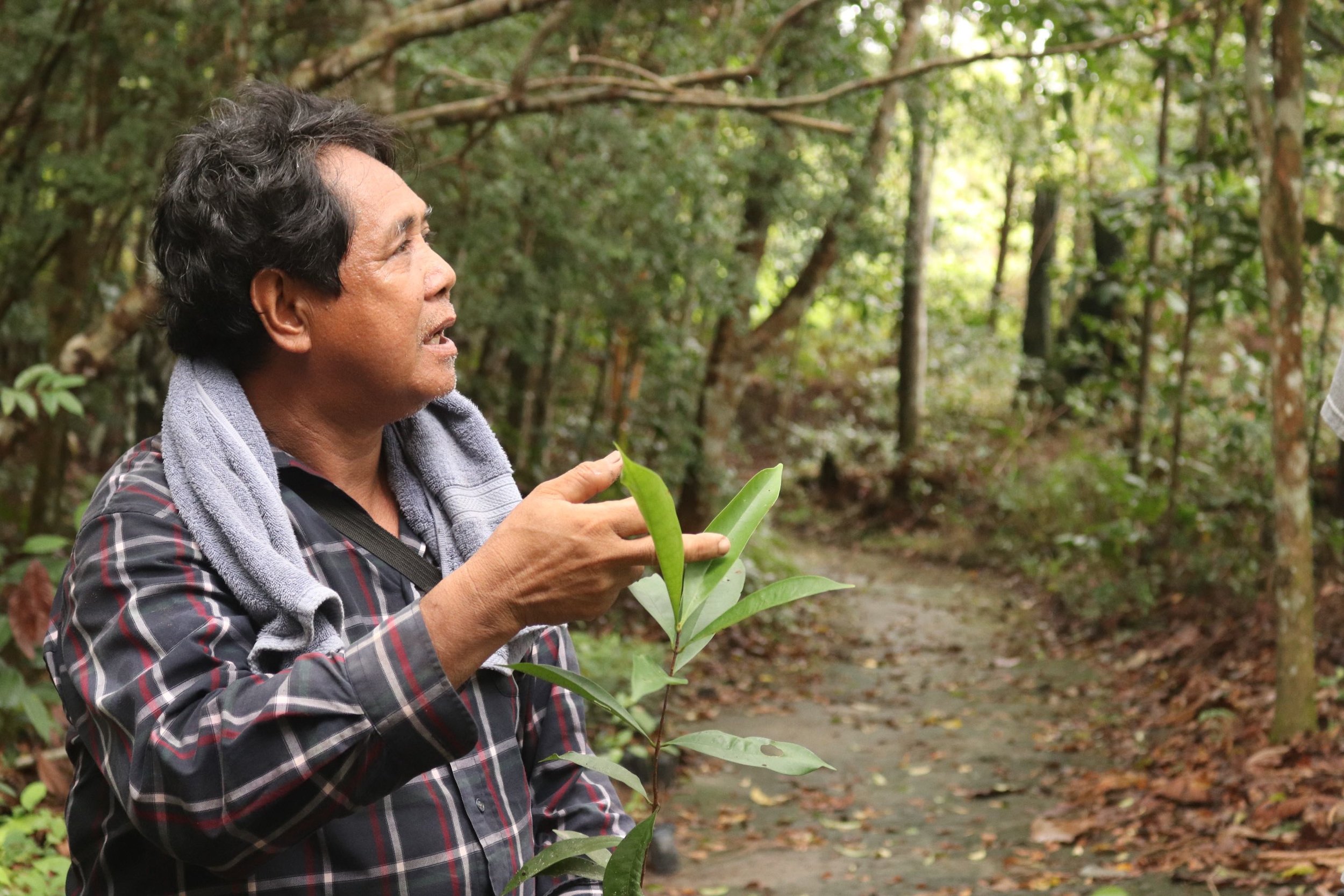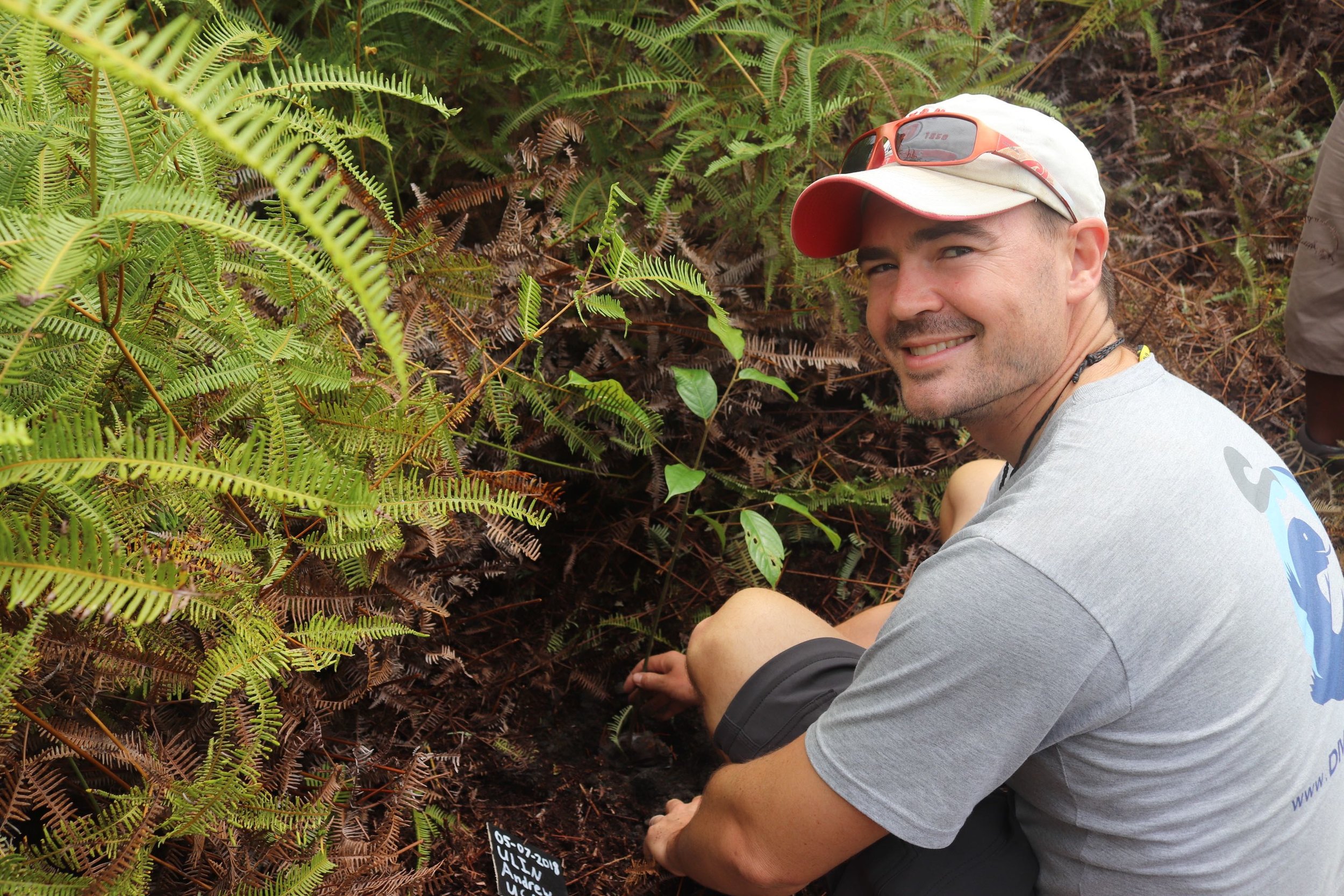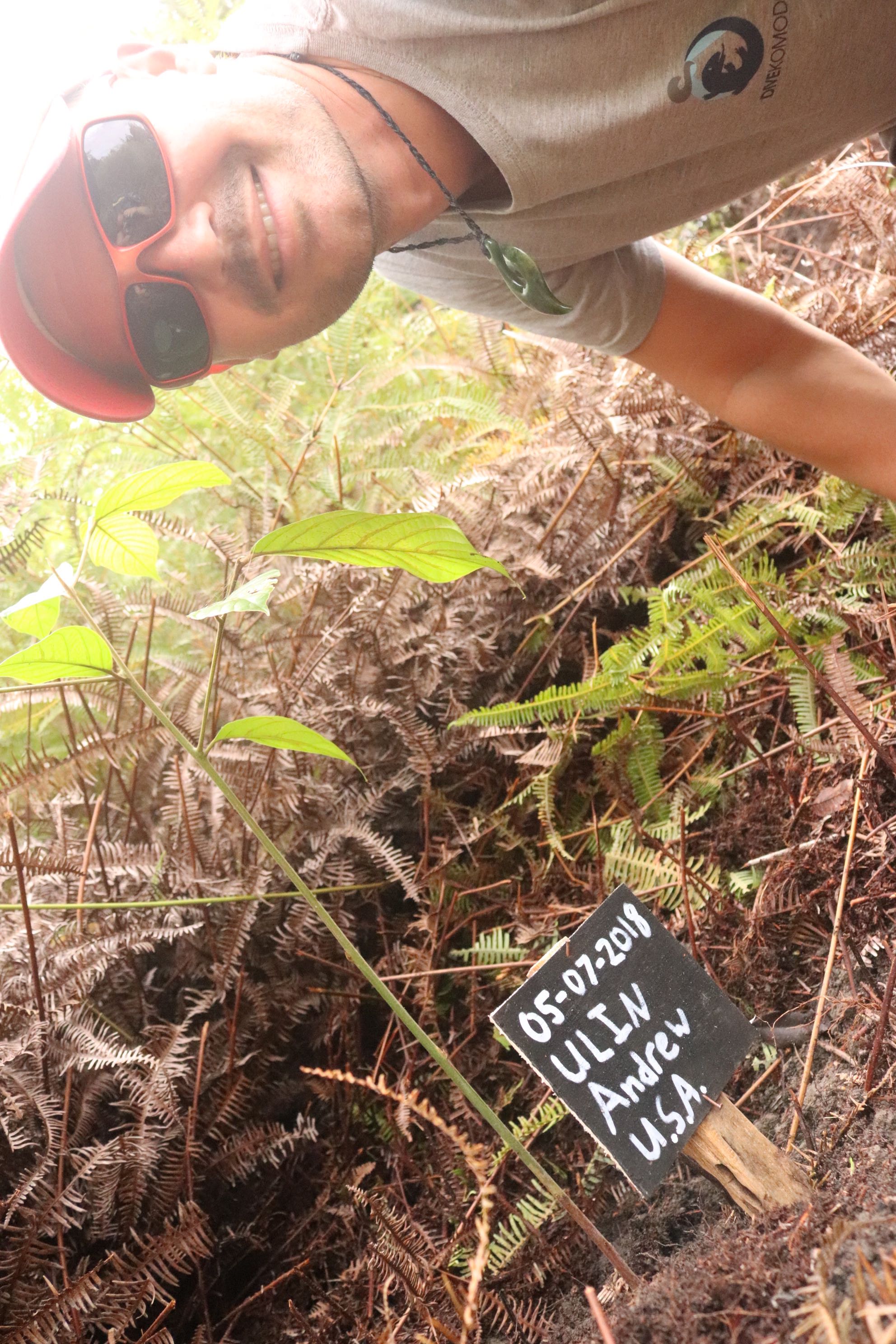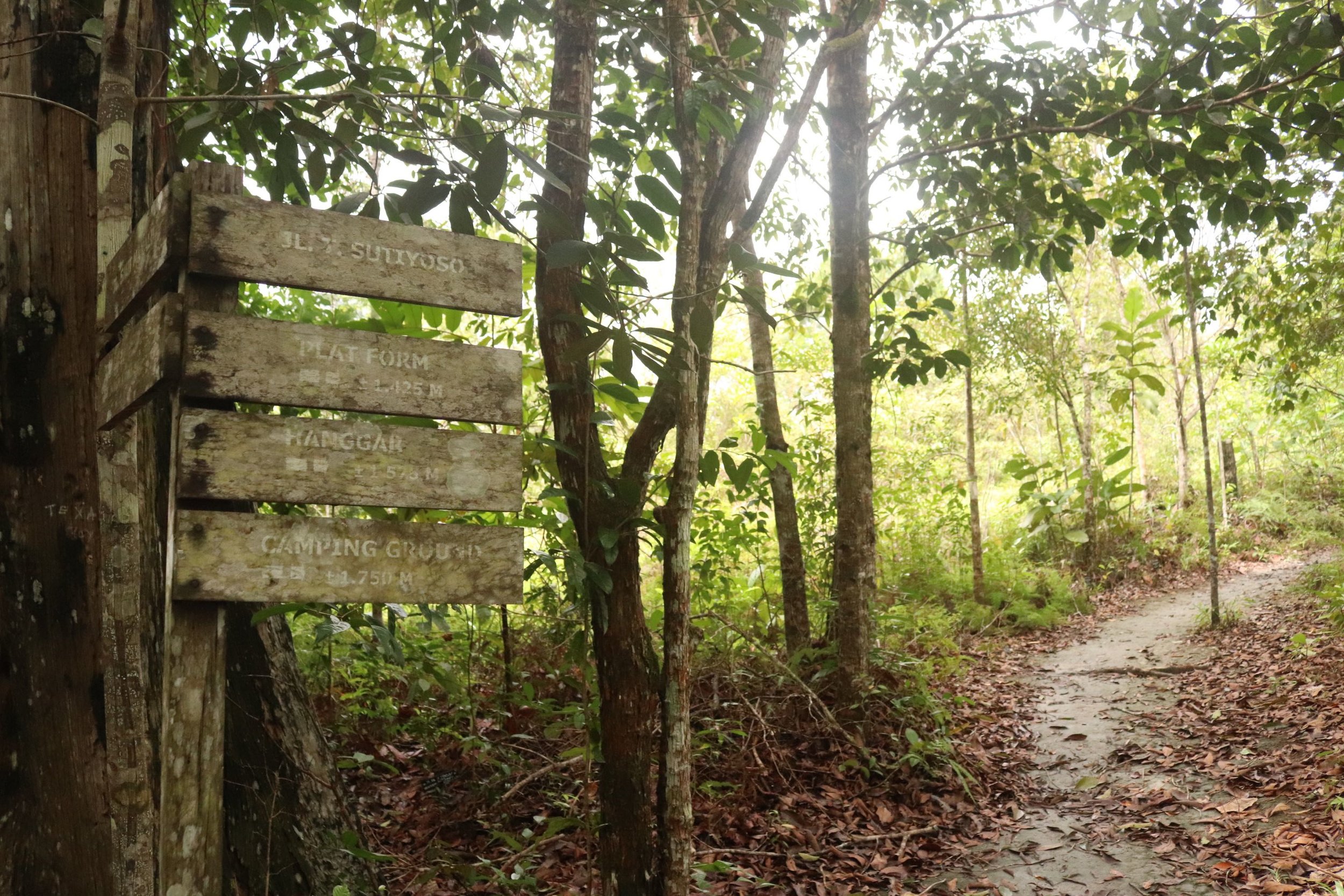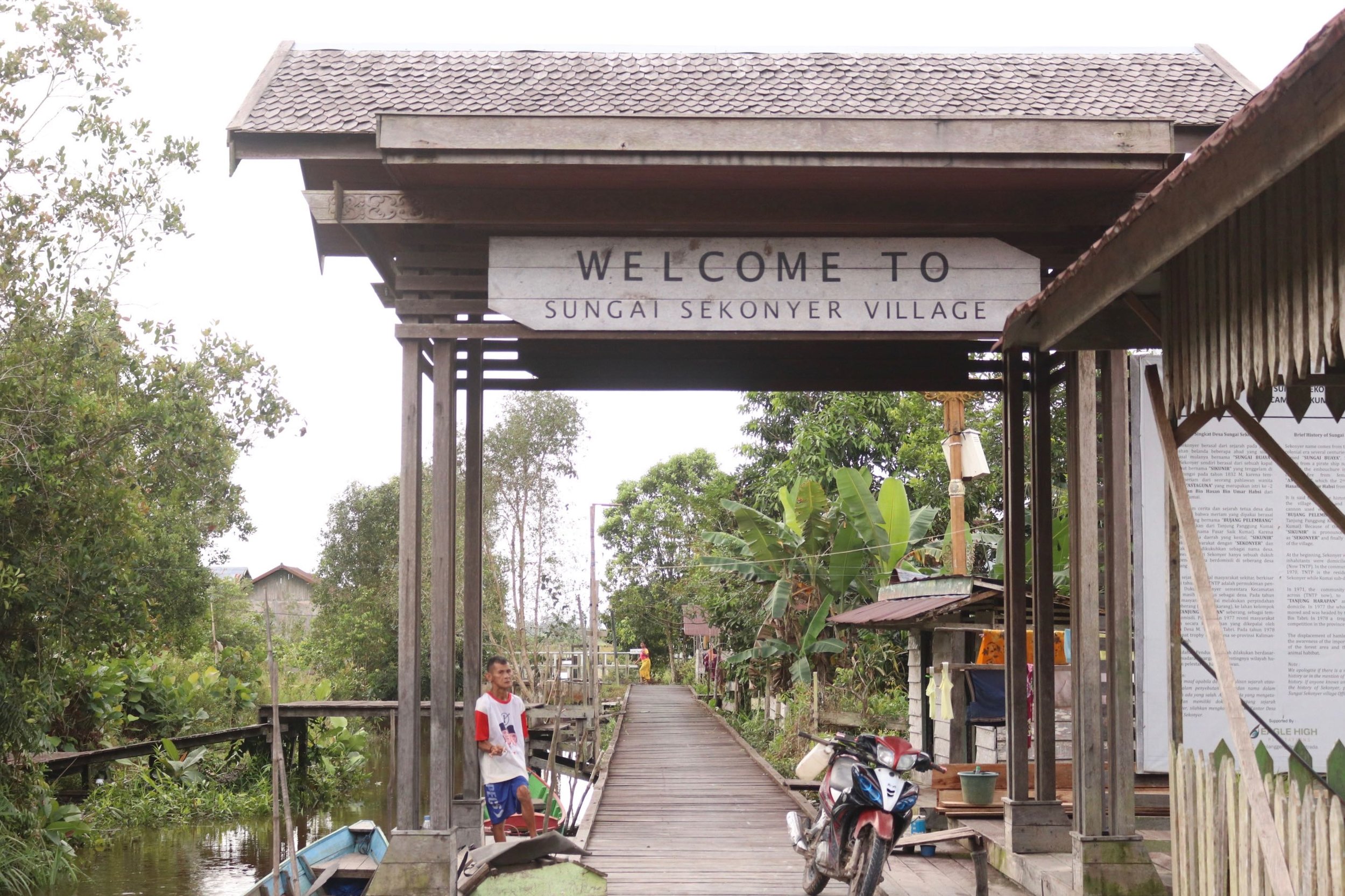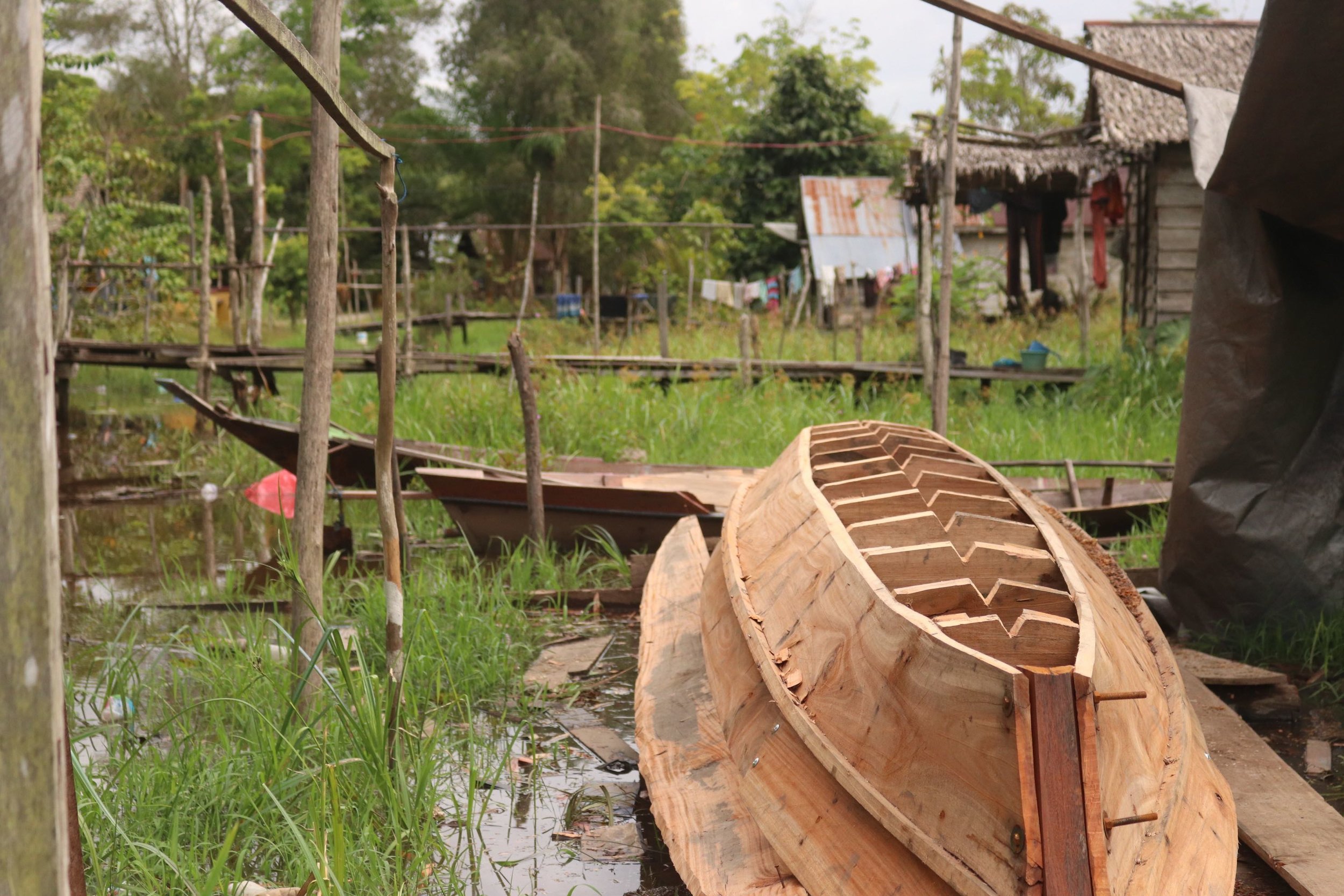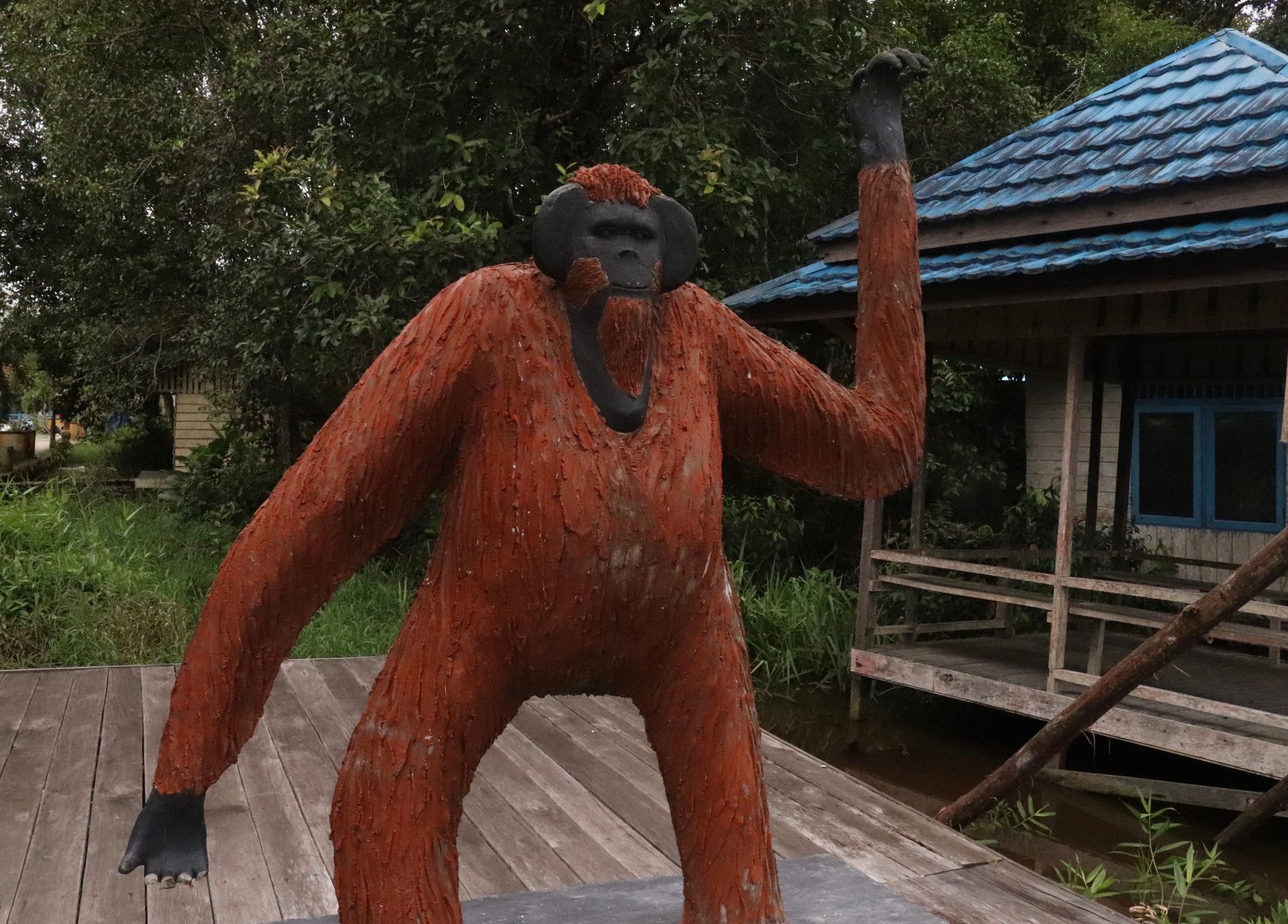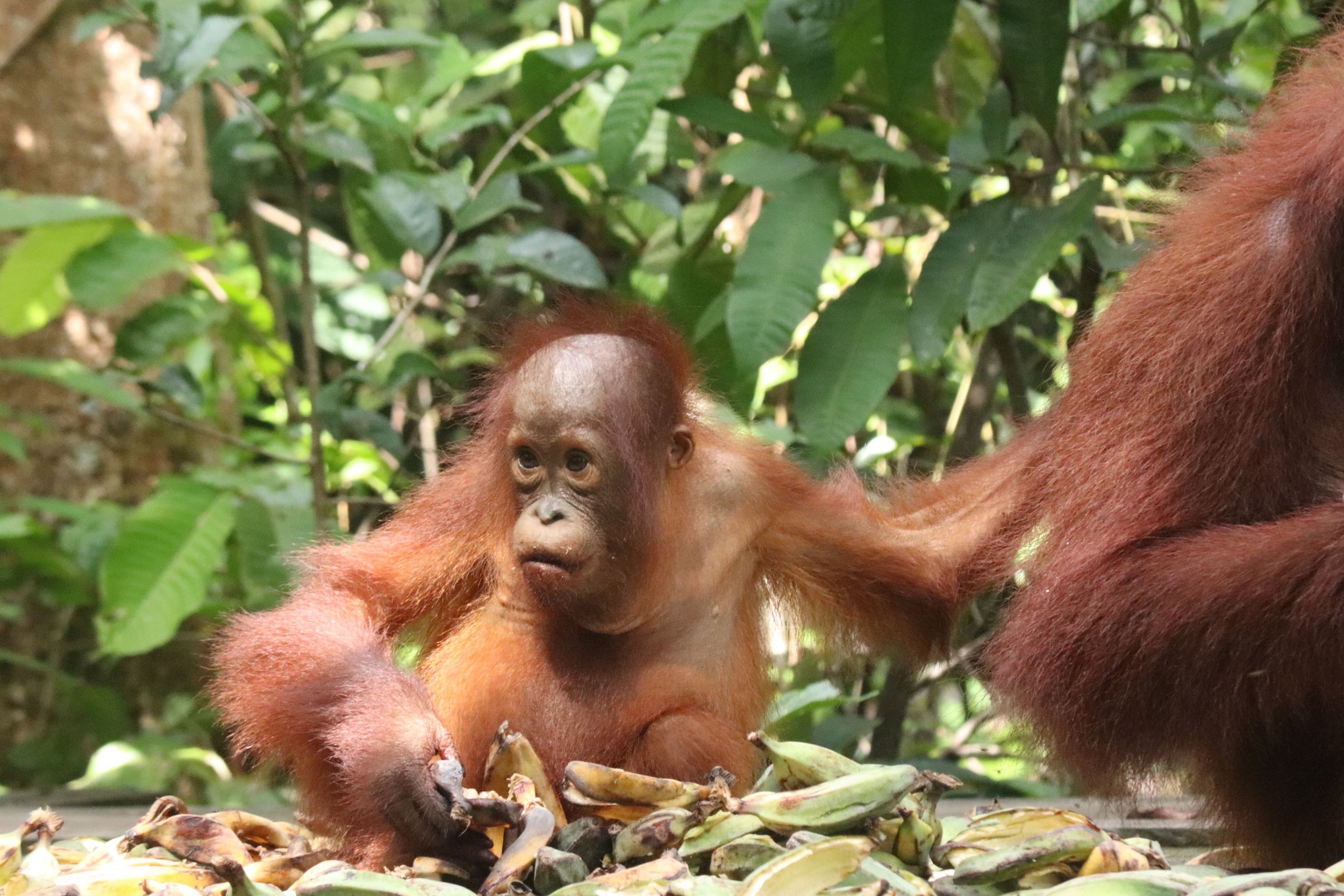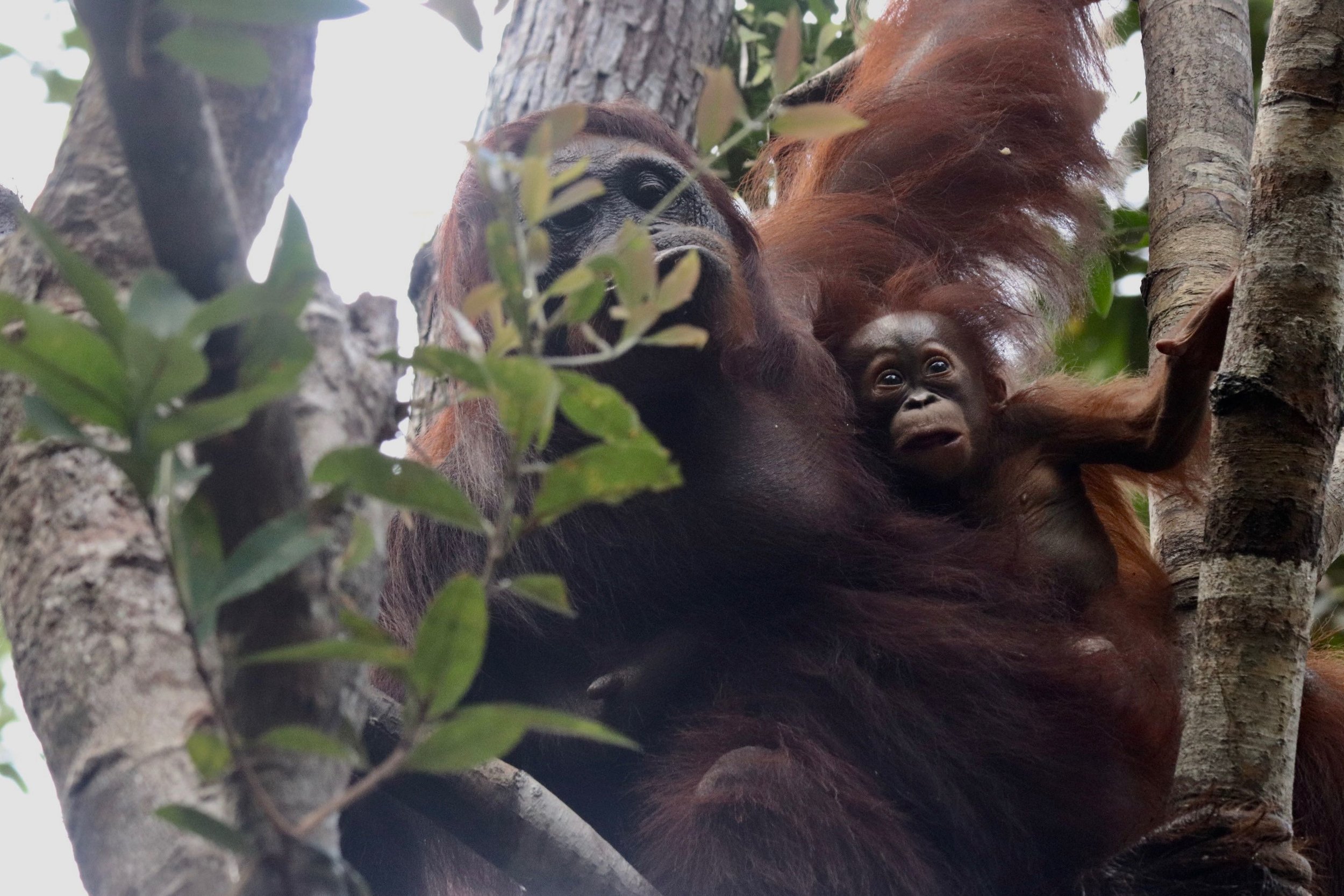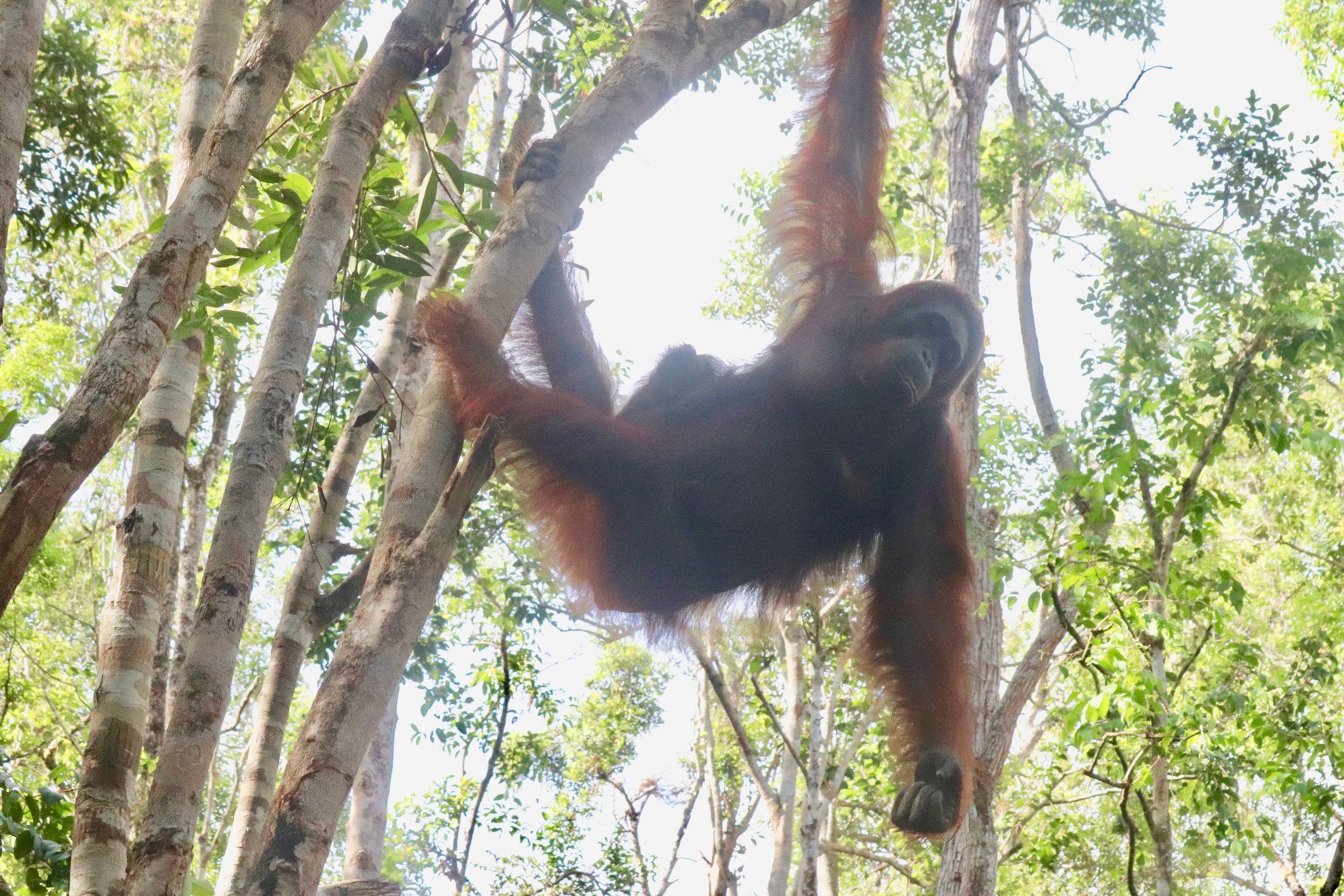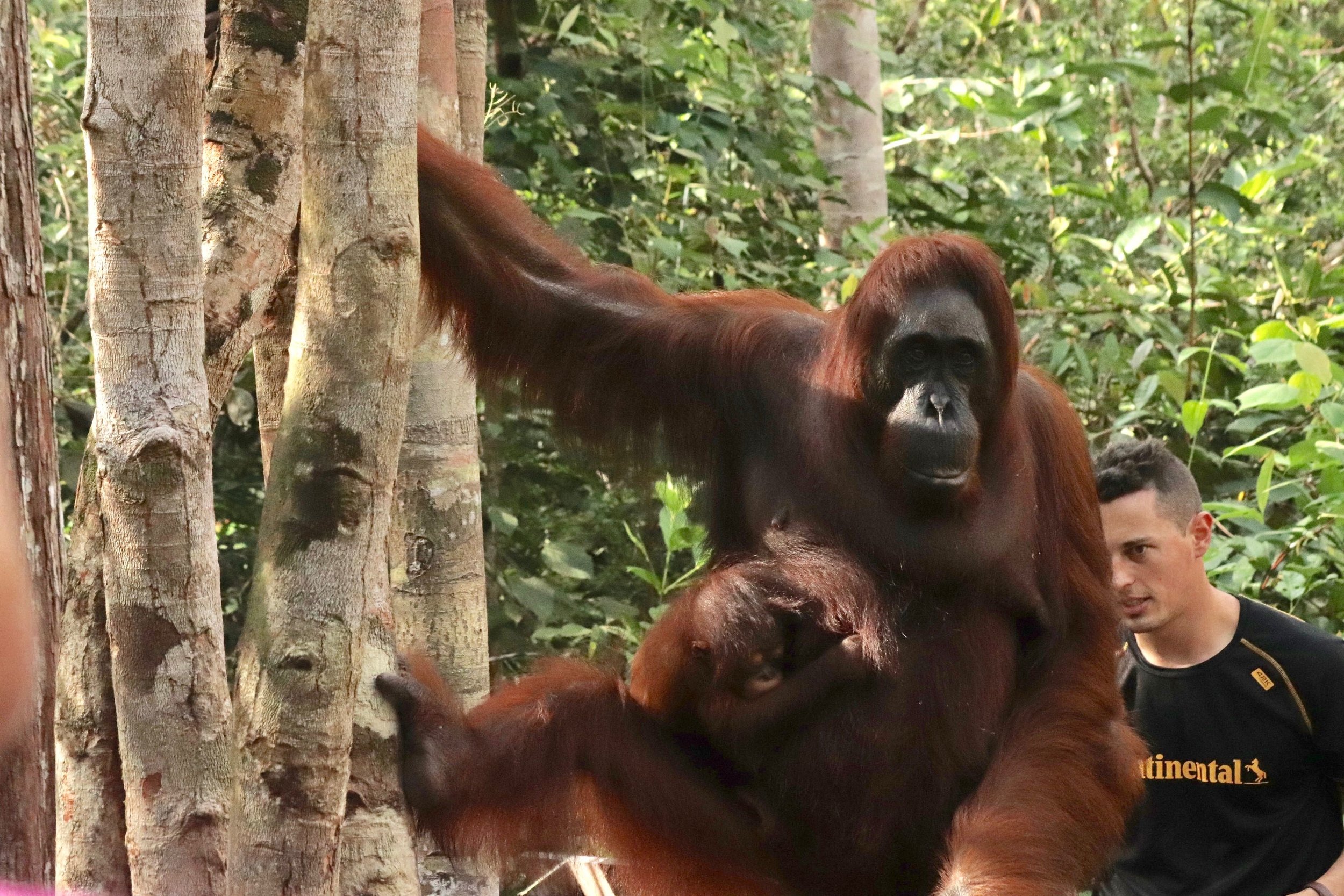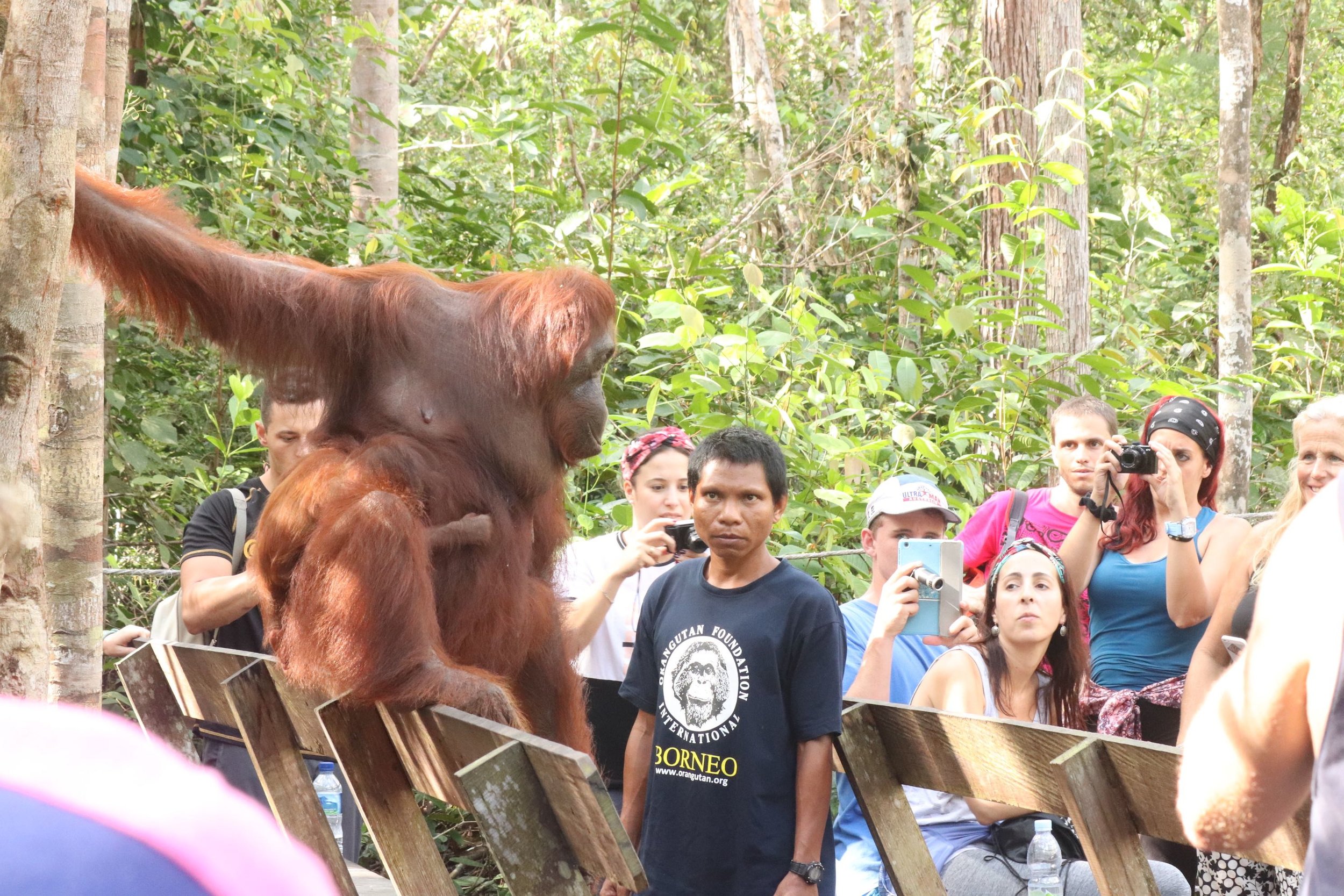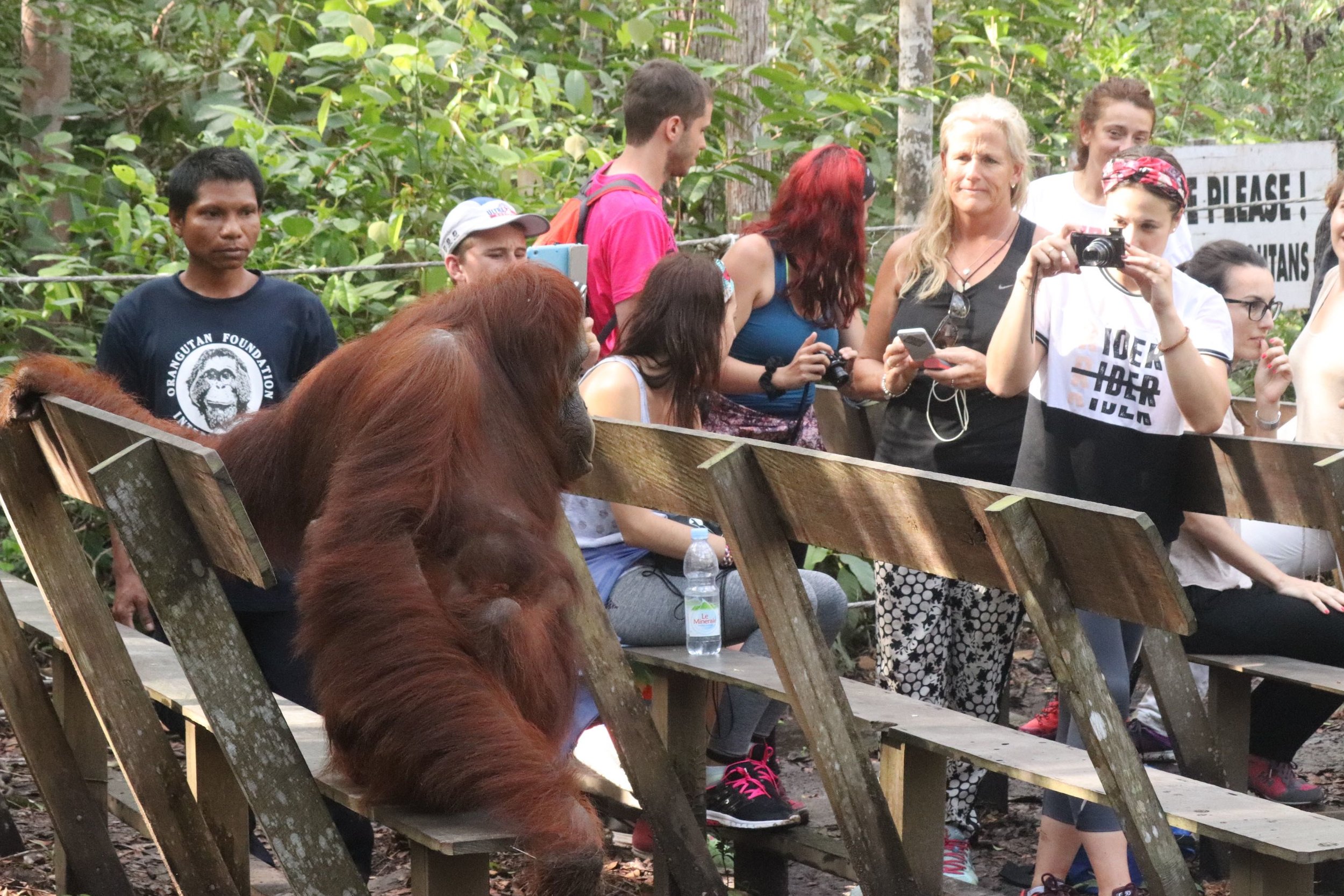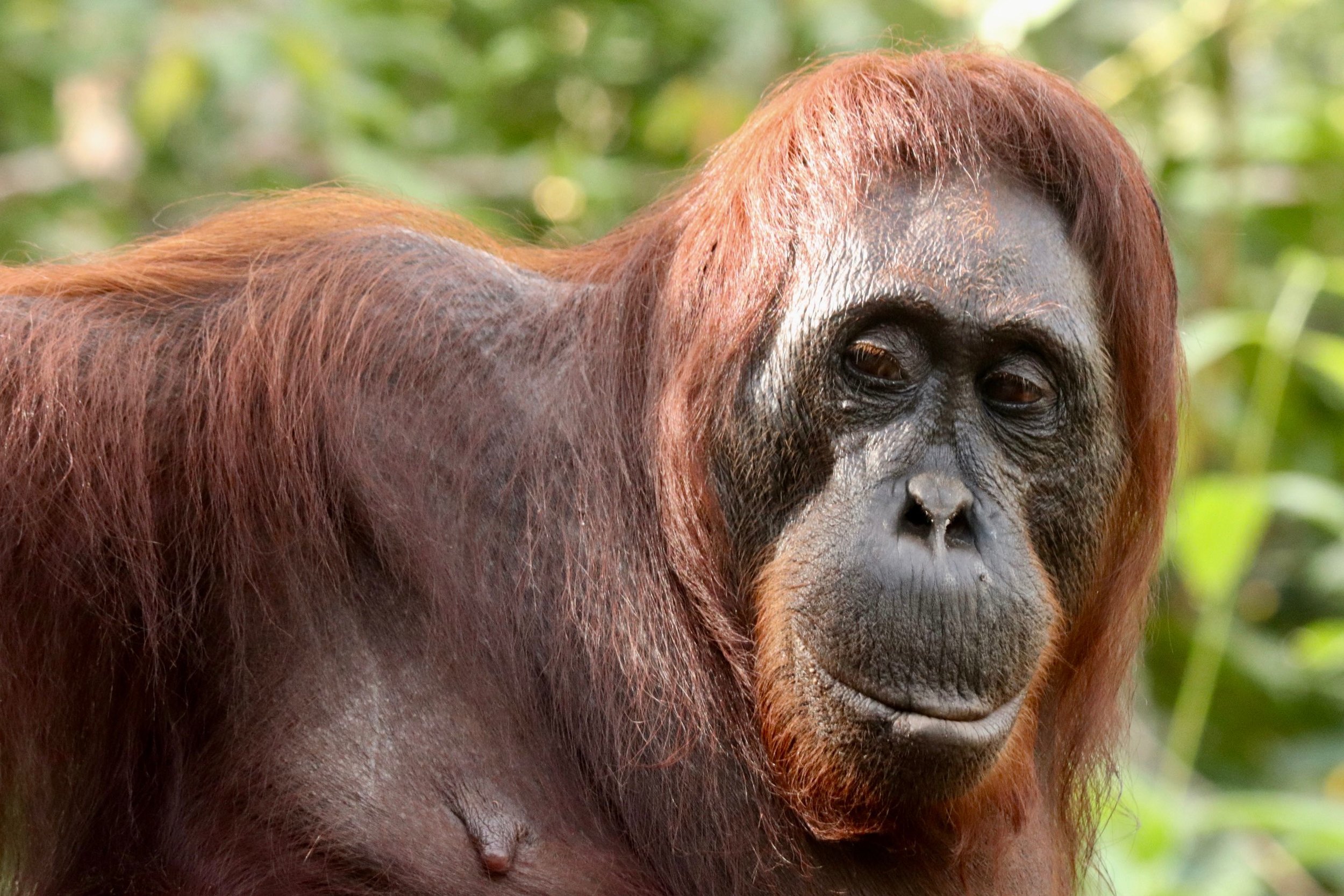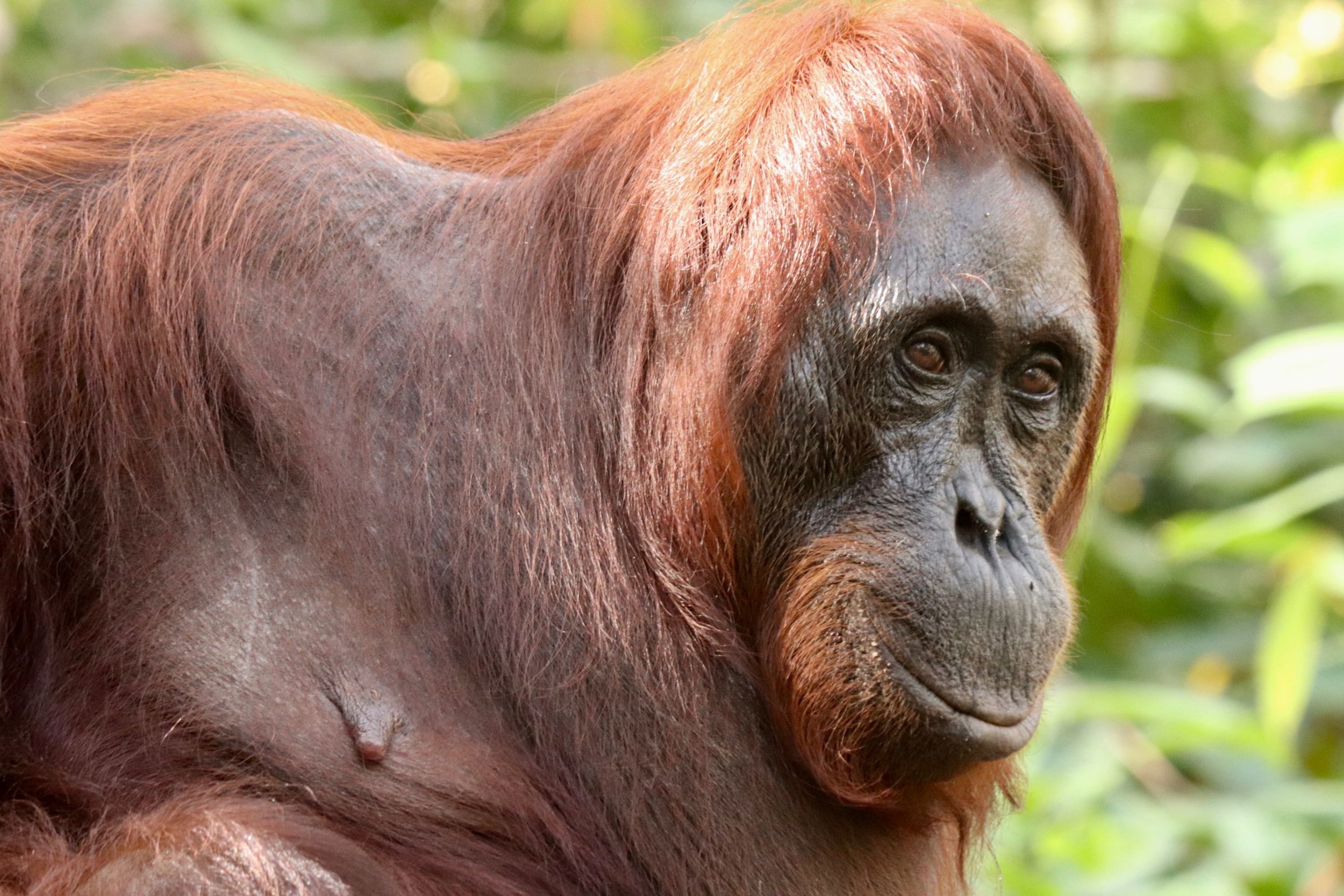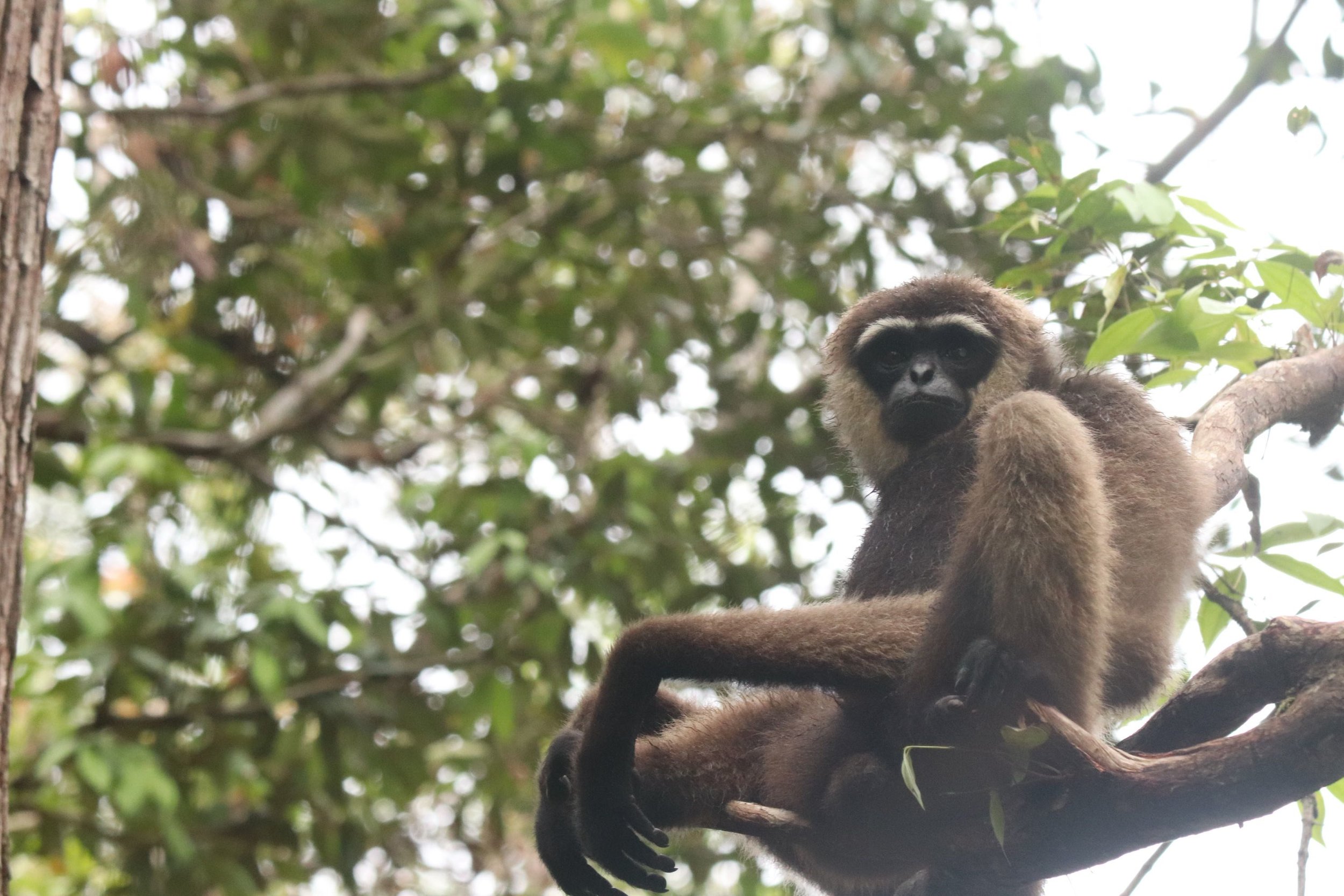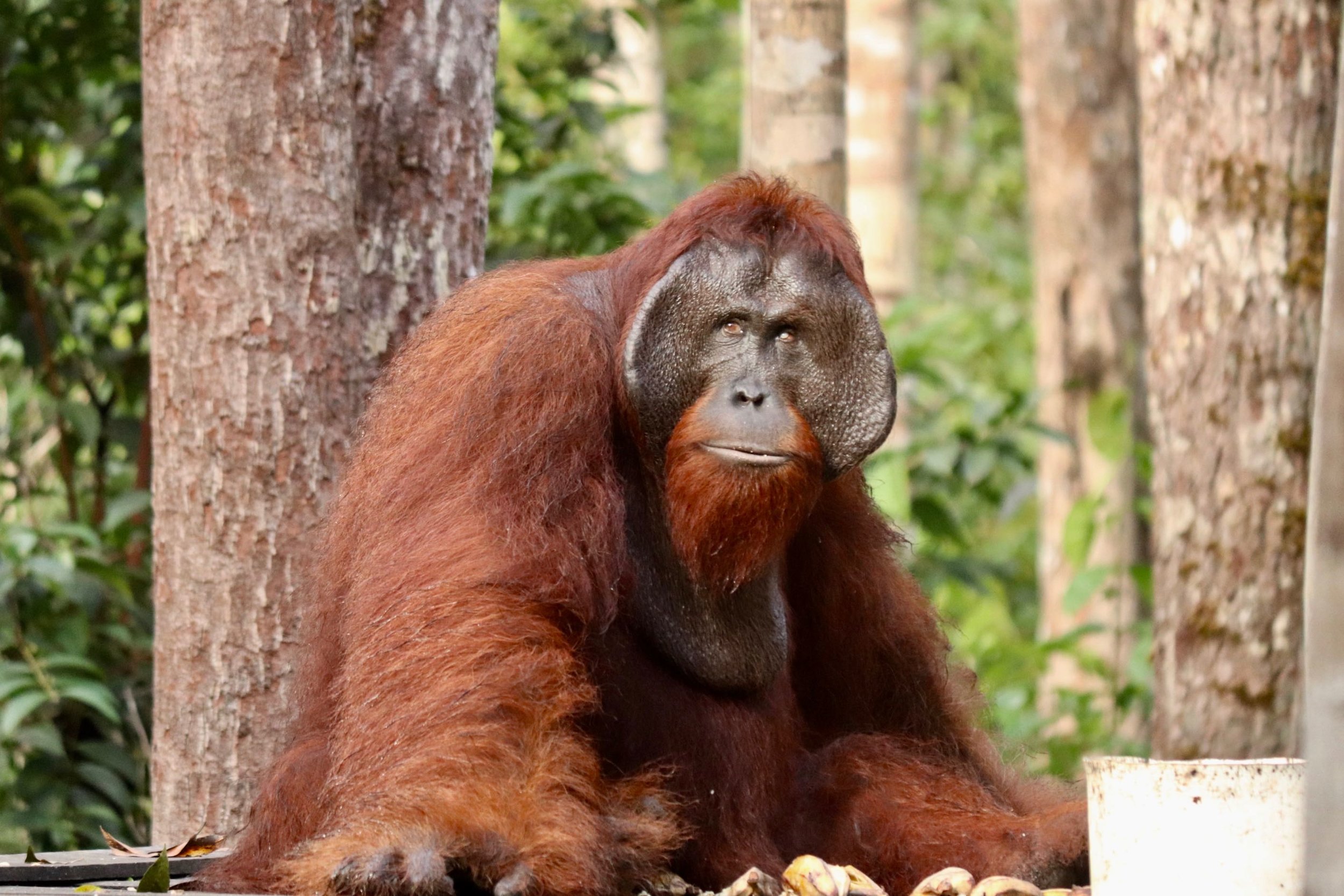The morning of the second day, we are deposited at the mouth of a dark jungle tunnel. Boards are nailed together on stilts, raising the walkway four feet off the ground to keep tourists' feet dry when the river floods during rainy season. The boards are as slick as ice, covered in a thin slime of rainwater, algae, and moss. The sun barely peeks through the canopy, only a gentle yellow-green hue lights our way. All manner of mushrooms grow in the rich soil of composted leaves, and fly-eating plants drape themselves from tree branches like a terrifying baby mobile. Butterflies of green, turquoise, black, sapphire blue, white and red flit around our faces. A white moth as big as a handkerchief flutters above us, casting a shadow as he crosses a beam of light.
Abruptly, we pop out into open sky and hot sun. A bed of thick ferns line the path, and only an occasional young tree seems to stand.
“What happened here?” Andrew asks our guide. It just doesn’t look right.
“Fire,” the guide explains. “They think illegal hunters probably started it.”
“What were they hunting?”
“Orangutans.” He says.
This is a sobering thought. These beloved fuzzy forest people are critically endangered right now, and as recently as 2015 their numbers took another sharp drop. Logging, mining, hunting and especially increased production of palm oil results in the cutting, burning, and clearing of the Borneo rain forest. Kalimantan (the Indonesian portion) has lost over 25% of it’s rainforest in the last twenty years alone. https://www.pri.org/stories/2016-12-30/indonesia-s-rapidly-disappearing-forests-four-charts. Animals are displaced and even villages of humans have had to move, losing long held land to palm oil production.
While the Indonesian government has taken some measures to encourage more efficient palm oil production and thus reduce the amount of forest lost, it still hopes to increase the palm oil export. It’s a highly profitable industry, with the largest consumers being India, Indonesia, China, and the European Union. https://www.slideshare.net/GreenPalmOil/top-10-palm-oil-consuming-countries-2015. Interestingly, the U.S. is the 10th consumer on the list.
As I read this list, I wondered why is the European Union included in those figures, with the U.S. being so low? Biofuels. When Europe committed to consuming more “sustainable, biologically safe” fuel, they looked to palm oil to fill their tanks. America prefers its home grown substitutes of corn ethanol and soybean based biodiesel. Apparently, intentions were good. Palm oil is more efficient than either corn ethanol or soybean based biodiesel, and it makes an excellent preservative. It’s used in everything from foods to laundry detergents, cosmetics, fuels, and paint. The problem is, it grows best in climate and dirt where rainforests and the Orangutans are supposed to be. The theory was that if a critical mass of consumption could be established, Europe could then push growers and producers to do so in an environmentally safe and sustainable method. This goal has not panned out, yet. https://www.transportenvironment.org/sites/te/files/publications/2016_11_Briefing_Palm_oil_use_continues_to_grow.pdf
Who can blame Indonesia for wanting to increase the palm oil export and trade? Just like any other nation, one of their objectives must be to create a profitable, vibrant economy to support their people. And, for all of Europe’s good intentions with “biodiesel,” they’ve inadvertently made things worse. Removal of Indonesia’s rainforest, also known as “the Lungs of Planet Earth” creates a net increase of greenhouse gases in the atmosphere by removing all that vegetation that typically absorbs carbon dioxide.
I read about these issues in one of the information booths in the National Park, right next to the room with the Orangutan inhabitants’ family trees. The researchers have been interacting with and learning about these animals in this National Park for three or four generations depending on the family, now. This is a perfect example of how this trip can sneak up on me and unravel ideas I thought I understood. Who could go wrong with biodiesel? (What if it results in deforestation?) What possible bad consequence can arise from distributing mosquito nets to reduce malaria deaths? (What if it increases a population density to such an extent that the nation can no longer feed its people? This is happening now in Papua New Guinea, and I recently read Madagascar, too.) These are just some of the issues I’ve observed first hand on my travels.
Is this an excuse to do nothing? No, but it does seem an example of how half measures to “help” allow us to embrace a smug satisfaction while leaving a problem unsolved or made worse. We need to reason out the consequences of our actions two or three moves down the chess board. We also must acknowledge that we have two equally important but sometimes competing interests on our hands: human’s ability to survive in our physical environment and our interest in creating economic prosperity. Both goals are important, we can’t have one without the other on a local and a global scale.
At the end of this trail, our guide introduces us to a man who lives in the forest full time working on the project of replanting areas damaged by fire. He rides his bicycle through areas of intact forest to find seeds he can carry back to his home, start in little pots, then plant in the damaged area. He explains what each plant is, its function and role in the jungle: fruit for animals, shade for smaller plants, tall trees for primates to swing from, etc. Then he lets us choose the one we wish to plant. We write our names, countries of origin, the type of plant, and the date on a little blackboard. Then, we follow a short trail to the damaged area. The botanist digs a hole for us in the spot he wants each tree.
I place my Sandalwood tree into its hole, then break apart the dirt the Botanist dug up with my hands. The soil is sticky and dark black; it’s difficult to convince smaller bits to part from its clump. It’s a gardener’s dream, rich with nutrients and cool on my hands. I tuck the soft soil around the baby stalk of my Sandalwood tree. I’ll admit it: I’m known to commune with my plants. At home, all my landscape trees were named, and I’d greet them each morning or in the evening when I’d arrive home. I’d thank them for fruit and flowers that make me happy. I’d complain to my office plant, Jon, about annoying opposing counsel, and I’d thank him for improving the oxygen content of my office air. I’m pretty sure Jon made me smarter. So, as I pressed the soil down with a firm pat, I listen to see what Baby Sandalwood might tell me.
Sandalwood is a rainforest tree that grows strong and tall, good for Orangutans to climb through. Humans like to cut it down as it is both a strong wood for building and enticingly aromatic. Aromatic oils and incense are made of its wood; I'm sure the popular Doterra oils offer a Sandalwood variety. Will my Sandalwood tree survive this unnatural scene and method of planting? The sun is bright and her tender baby leaves are not well shaded by the ferns currently taller than she is. Everything is backwards here: she should be tall and strong, shading these ferns. I hope she will live. I take a photo of my tree, then Andrew’s. I’m tickled by the idea that I helped some other creature half way round the world from my regular home. I wonder what unintended consequence I’ll have caused. Hopefully, only good. I’ll probably never know.
When we visit a village located on the outskirts of the National Park, I marvel at the fact that these people agreed to move their entire town out of the newly protected forest area. I imagine the need to move was especially frustrating considering the move is only necessary because the forest is being destroyed for the sake of profiteering. As we walk around the village I can see they rebuilt - maybe even better than before. They have sidewalks, a large school for the children, a library, even solar powered street lamps. Everyone seems as happy and as well off as the other Indonesians we’ve met. Would I do that? Pick up my family, leave my home and ancestral land to rebuild somewhere else for the sake of an Orangutan and the rainforest? Hell, I can't even seem stop using Ziplock baggies.
Have no doubt, the Orangutans are pretty special. All tolled, we visited three different groups of Orangutans on our trip, and we watched each group for about two hours. Each location had differences resulting from the personalities of the Orangutan individuals/families. At the first location, the Alpha Male seemed to be more welcoming to group interaction. Mamas and babies, younger males and females all seemed to climb up and down the trees, visit the feeding platform, and interact while the Alpha Male was present.
At the third location, only one Mama and her baby came to the feeding platform while we were there. She seemed continuously on edge, the baby always grasping a tuft of Mama’s fur in case she had to evacuate in a hurry.
At one point, she climbed up and swung over to a tree located directly above the crowd. Eating bananas and corn from this perch, she almost choked on something and spewed corn bits and snot onto the crowd below. Then, she decided to climb down and join us for a closer look. Down the tree she slid, perching on the last bench.
“Move, move!” The Researchers commanded as the crowd, not knowing what to do, froze in place and started snapping photos. Personally, she scared me enough just being in the tree above us that I had already moved to the far side of the area using my long lens to take my shots. Later we read that a female Orangutan is about four times stronger than any human, a male eight times stronger. The Researcher put himself between the crowd and the Orangutan and proceeded to engage in a systematic method of eye contact. I don’t know exactly the purpose or the strategy, but I was enthralled to watch. He seemed to say: “I’m the Alpha Male here. I don’t want to pick a fight, but be cool, okay?” He’d look into her eyes with a serious face for a few seconds, then look away, into her eyes, away.
Mama, on the other hand remained siting on the top of the bench, one arm still clinging to the tree behind her, poised to climb back up if she felt like it. She seemed to look around at the crowd, pausing and smiling in each direction. I’m curious of her thoughts. It could have been “Hmmm, do I feel like tearing off this one’s face? Or this one’s face? You know, just to demonstrate my superior strength.” But, to me, It just seemed like she wanted pose for a better selfie.
Eventually, she climbed down off the bench, then sauntered through the crowd hand-knuckles first, feet following, Baby astride her hip to make her exit. For a long time, nothing happened. A number of people packed up their cameras and left. A Gibbon jumped and swung wildly across the canopy, quickly down to the feeding platform to steal a few bananas, stick them three wide into his mouth, then jump and swing away. He was so fast and frantic, I had a hard time following him with my camera. A squirrel poked his head from behind a tree and made the same fast break.
We thought the show was over until suddenly, trees in the distance began shuddering with the weight of a large Orangutan on fast approach. An enormous Alpha Male arrived at the feeding platform, climbed down, and took a long slurp from the bucket of coconut milk and water. He looked around at the crowd with a sullen, angry “don’t mess with me” kind of stare. He starts eating. From behind us, trees bend and shake with the approach of a smaller Forest Person. The Alpha Male looks up and scowls at the approaching party who stops dead in his tracks. This smaller male orangutan sits in the tree, frozen in place, only shuffling around branches of the same location. He blows a raspberry with his lips, but he does not come any closer. The Alpha Male looks out into our crowd as if to say "Don't start with me."
It’s clear these animals - whose DNA matches 97% of our own have their own complex social structure and interaction. I can see why Researchers have been fascinated to study them for all these years. They’ve taught us so much about humankind’s own ancient history.
The Researchers call time and tell us we must leave before we see the end to this saga. The experience cruising the black water river is only surpassed for me by the unique opportunity to watch these animals in their home territory. To be able to see them swing so deftly from tree to tree is something you can never replicate in a zoo format.
At the close of our trip, we declared one and all that we each had a fantastic time. Like visiting the glaciers in New Zealand or Glacier National Park in the U.S., this is an experience that may not be available for me twenty or fifty years into the future. If you have a week to spare, we'd highly recommend a river trip through the Tanjun Puting National Park.


